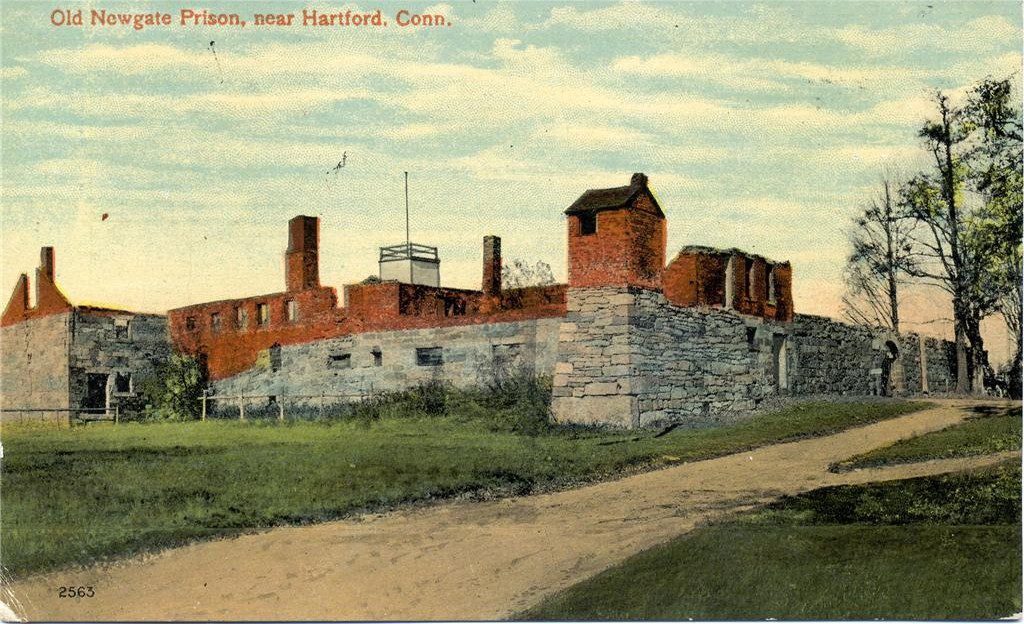
Old Newgate Prison
With the growth of the first settlements in New England, crime and punishment became common issues, just as they had been in the Old World. However, the setting had changed and so the early codes and methods of punishment mirrored the coarse, difficult nature of these early pioneer settlements:
Branding of the condemned, in accordance with the crime.
Docking-cutting off part of an ear for each crime committed.
Ducking-binding the criminal to a chair and lowering him into and beneath the water.
Whipping-(the most common punishment) the entire town would be assembled to witness the whipping of the convicted criminal while he was tied to a whipping post.
Stocks-the criminal was forced to sit with his legs captivated in a wooden frame with foot holes cut into it.
Pillory-the condemned was captivated by head and shoulders into a wooden frame which was located in the town square; it was common practice to throw rocks and rotten fruit at the criminal while he was so incapacitated.
Not long before the outbreak of the American Revolution, it was decided that an alternative to the existing corporal punishments should be made available in Connecticut. The intent was to separate the criminal from society and to employ him at some form of labor to offset the cost of such an incarceration. In May of 1773, the Connecticut General Assembly appointed a committee to visit an inactive copper mine in the area now known as East Granby, to determine if it could be used for “the purpose of confining, securing and profitably employing criminals in lieu of the infamous punishments now appointed.”
“In the night after the 24th of August (1775), New-Gate Prison was broke up, and the following prisoners made their escape: viz. the notorious Richard Steel. He is about 5 feet 9 inches high, pitted with small pox, has been twice crop’d and branded, had on a green coat. Also, Richard Marshfield, about 5 feet 10 inches high, about 25 years of age, black hair. Also, James McGinley, an Irishman, about 5 feet 8 inches high, black hair, darkish complexion, speaks broad, wore a claret coloured coat, white diaper jacket, a pair of spotted Manchester breeches. Whoever will take up said fellows and return them to the prison from whence they escaped shall have three pounds reward for each, paide by John Viets.” Connecticut Courant, August 28, 1775
When the committee visited the mine, they discovered that it was made up of a network of tunnels, and two vertical shafts. The mine became a prison as a wooden lodging was built above ground. Prisoners were to be kept deep underground and mine copper ore under the supervision of expert miners.
The prison overseers confidently stated that it would be impossible for anyone to escape from Newgate Prison.
But such was not meant to be: the first convicted criminal to arrive made his escape within 18 days. The next three prisoners to be incarcerated at Newgate made their escape attempt shortly after their arrival, by digging their way out. But on the way, they caused a cave-in, and their bodies were never found.
Time after time, prisoners arrived and prisoners escaped. And those who didn’t escape included younger men who were taught the tricks of their trade by the more experienced hands who worked alongside them in the mine.
They worked in a place they called “hell,” where prisoners “cursed and swore, and fought and committed other abominations.”
As time passed, Newgate Prison’s reputation grew worse and worse, until it was closed in 1827. Curiosity seekers began to visit regularly and it was eventually turned into a sort of museum. Today, Old Newgate Prison operates as a state-owned museum, and is opened to the public during the warmer months.